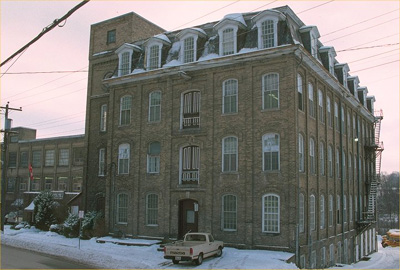Penman Textile Mill National Historic Site of Canada
Paris, Ontario

General view of mill building
© Parks Canada/Parcs Canada, 1991
Address :
140 West River Street, Paris, Ontario
Recognition Statute:
Historic Sites and Monuments Act (R.S.C., 1985, c. H-4)
Designation Date:
1989-06-22
Dates:
-
1874 to 1874
(Construction)
Other Name(s):
-
Penman Textile Mill
(Designation Name)
Research Report Number:
1986-SUC, 1989-SUB, 2020-CED-SDC-04
Plaque(s)
Existing plaque: Penman Manor, 140 West River Street, Paris, Ontario
This stately mill complex, along with other Penman Manufacturing Company mills on the Grand River and beyond, comprised the largest woollen knit goods producer in Canada during the late 19th and early 20th centuries. John Penman began manufacturing on this site in 1868 and constructed a new knitting mill in 1874, powered by the Nith River. Generations of mill families worked at this complex, which came to specialize in hosiery. For nearly a century, Penman’s No. 1 Mill was the pride of the firm. The surviving buildings illustrate a time when the Grand River Valley was the heart of the Canadian knit goods industry.
Description of Historic Place
Penman Textile Mill National Historic Site of Canada is located on the Nith River’s east bank in Paris, Ontario. Established in 1868 as a knitting mill complex, the mill’s remaining structures comprise three large multi-storey industrial buildings located at 120, 130 and 140 West River Street, and an adjacent tall, tapered square, brick industrial smokestack. The Penman Mill Complex originally comprised two components, the site on the Grand River which no longer exists, and this remaining one on the Nith River. Official recognition refers to the three extant buildings now converted to residential dwellings. The designation includes the three properties associated with the surviving mill buildings of the Nith.
Heritage Value
Penman Textile Mill was designated a National Historic Site of Canada in 1989. It is recognized because:
—from its formative years in the 1870s to the second half of the 20th century, it was the largest
knit goods mill in Canada;
—it was the first and most important plant of the Penman Manufacturing Company, long the largest Canadian knitting firm; and,
—it is located in Ontario, in the Grand River Valley, the heart of the knit goods sector in the 19th century.
Penman Textile Mill was established in 1868 to manufacture fine quality knit goods and contributed to the textile manufacturing industry that developed in Canada between 1840 and 1870. The Penman Mill, as part of the woollens, cotton,and knit goods sectors of the Canadian textile industry, speaks to the national historic significance of this branch of commerce. Mills were built in the Mississippi Valley, where waterpower, labour and wool supplies were abundant. In 1868, John Penman moved to Paris, Ontario, where he founded a new mill with W.E. Adams. Constructed in 1874, the current building at 140 West River Street replaced the earlier 1868 building destroyed by fire. The mill grew to become a major producer of cotton and woollen knit goods specializing in hosiery and underwear and continued expanding until the early 1900s. In 1906, the company was acquired by Dominion Textile and renamed Penmans Limited. It subsequently changed hands many times, becoming part of Dominion Textiles in 1965, and in 1970, the mill was sold to Pride of Paris, a drapery manufacturing business. The surrounding ancillary buildings and some mill buildings have been removed from the original group of structures. Between 2005 and 2008, the three principal mill buildings were converted for residential use.
Source: Historic Sites and Monuments Board of Canada, Minutes, June 1989 and 2005, and September 2020.
Character-Defining Elements
Key elements contributing to the heritage value of this site include:
— the location on the Nith River’s east bank;
— the setting on a flat lot in a former industrial area surrounded by trees and adjacent to urban housing in Paris, Ontario;
— the L-shaped massing of the large four-storey mansard block, and the multi-storey, rectangular massing of the adjacent buildings, and the tall, tapered square, brick industrial smokestack;
— the quality of the construction materials used, notably limestone exterior walls;
— characteristics common to late 19th-century textile mills in Canada that include the austere elevations, the nearly flat roof, the stair towers, and the regular fenestration pattern;
— remaining original interior configuration, features and finishes;
— the spatial relationship between the three remaining buildings and their relationship to the river;
— the integrity of any surviving or, as yet, unidentified archaeological remains which may be found within the site in their original placement and extent.